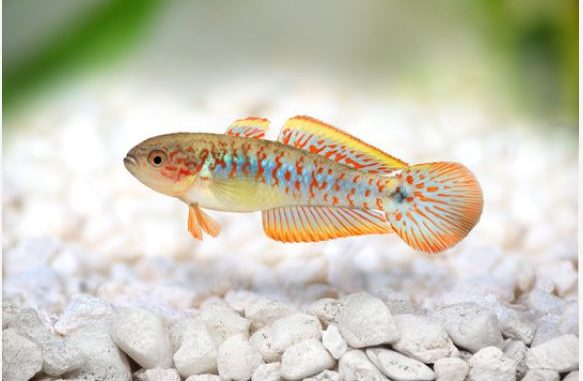
Often overlooked as a suitable option for a community aquarium, Peacock Gudgeons are stunning fish with distinct and fun personalities. They will add both beauty and life to your aquarium environment and you’ll enjoy developing relationships with them.
In addition, they are not difficult to care for (although they are, by all accounts, picky eaters.) They are peaceful fish that play well with others in the aquarium.
We’ll introduce you to the Peacock Gudgeon, covering their origin and history, and tell you all you need to know about caring for these beautiful creatures. Let’s dive right in to explore their behaviors, appearance, optimal tank conditions, diet, and breeding so that you can decide if Peacock Gudgeons are right for you and your tank community.
TABLE OF CONTENTS
Peacock Gudgeon Facts & Overview

| Category | Rating |
| Care Level: | Easy |
| Temperament: | Peaceful |
| Color Form: | Black, red, white |
| Lifespan: | 4-5 years |
| Size: | 1-2.5 inches |
| Diet: | Omnivore |
| Family: | Eleotridae |
| Minimum Tank Size: | 15 gallons |
| Tank Set-Up: | Freshwater with plants and rocks |
| Compatibility: | Peaceful commnunity |
The word peacock sparks an immediate visual of the stunning bird with colorful feathers completely open. The Peacock Gudgeon is justifiably named after the famous bird, sporting myriad colors and patterns on their tiny bodies, including the trademark peacock eyespot.
The Peacock Gudgeon, scientific name Tateurndina ocellicauda originates in Papua New Guinea. Found in shallow freshwater settings, Peacock Gudgeons are also found in Australia and New Zealand.
Sometimes called Peacock Goby, the Peacock Gudgeon does not actually belong to the Goby family; instead, it’s a member of the Eleotriafe family and the only species in the genus Tateurndina.
Though they originate in Oceania, most Peacock Gudgeons sold for home aquariums are bred in captivity. Easy to care for, Peacock Gudgeons are an excellent choice for novice hobbyists, and interesting enough to pique the attention of even the most seasoned aquarist.
The hobbyist will need to pay a little more attention to care when it comes to breeding these vibrant beauties, and, as with all aquarium habitats, providing high-quality nutrition and pristine tank conditions.
Peacock Gudgeons will appreciate a lush and decorated environment and excellent filtration.
Typical Behavior
A generally peaceful community member, the Peacock Gudgeon will not stir up the pot when they are around other fish that are also non-aggressive. They prefer to be in groups of 6-8, but will do just fine in a pair — just make sure you have at least one buddy for them.
Sometimes the males in the group will get a little hot under the fin and get aggressive with each other, but tempers usually cool quickly, and injuries are uncommon.
The most fun you’ll have is watching the Peacock Gudgeons swim and play with the plants in their surroundings. It’s so satisfying to watch these beautiful and vibrant fish swim around with unabashed joy. It improves the hobbyist’s mood just watching them frolic.
When they feel really untethered and calm, you’ll see them swim out in the open, almost as if displaying their unique appearance.
Pro tip: It’s important to note that Peacock Gudgeons are gifted jumpers, so you’ll want to make sure your aquarium is equipped with a tight-fitting lid.
Make sure you give these Peacock Gudgeons plenty of hiding places so that they have an escape if they feel threatened.
Appearance
Peacock Gudgeons are truly a joy to behold. With their vibrant coloration and signature peacock eye, these little fish really add sparkle and life to your aquarium community.
The body of the Peacock Gudgeon is a silvery blue with red lateral dots. As we mentioned, although they are sometimes referred to as gobies, they are not true gobies and do not have the fused pectoral fins that mark a genuine goby. Their bellies are colored in a mellow yellow hue, and you’ll see yellow on the edge of their fins. Females can be distinguished by the added black stripe on their fins.
Of course, the aforementioned eyespot at the base of the tail fin is how the Peacock Gudgeon gets its name.
In addition to the blackfin stripe in females and the forehead hump in the males, you can distinguish males and females by their length, with females being a little shorter than males. Females also develop an obvious yellow patch on the abdomen when they are preparing to spawn.
Juvenile Peacock Gudgeon
It takes 6 to 8 months for young Peacock Gudgeons to reach maturity. They may grow a little larger after this point, but they are essentially full-size.
Habitat and Tank Conditions

Peacock Gudgeon does not swim as much as some other nano fish like the bloodfin tetra, so they don’t need quite as much room for swimming.
If you’re just keeping a school of 6 or more Peacock Gudgeon, a 15-gallon tank should suffice. Increase the tank size for a larger school or a community tank that has myriad species.
In terms of habitat, they prefer a lush and decorated aquarium, as it harkens back to their natural habitat in the streams and ponds of Oceania. You will notice your Peacock Gudgeon thriving in plant-heavy environments.
Anubias, Java fern, and water wisteria are excellent choices for Peacock Gudgeons. It’s important to provide them with a plethora of vegetation so that they have places to hide if they feel threatened or stressed, and they enjoy swimming through plants in the tank — you’ll really see content fish when they are surrounded by plants. You will probably even see their colors become more vibrant when they’re surrounded by live plants.
Choose hearty plants for your Peacock Gudgeon tank; they spend so much time interacting with the plants that more delicate varieties will not last long.
For a substrate, choose darker sand that reminds them of their natural habitat. Try to avoid gravel as it could scrape their bottom sides and injure them.
As we mentioned, they like to hide in the plants when they feel threatened, and adding decorations to your aquarium like caves or castles can provide even more hiding places for Peacock Gudgeons. And as you’ll see later, you’ll need a cave if you’re planning to breed them, or if they decide to breed.
Rocks and driftwood are other tank additions that will help keep the Peacock Gudgeons content.
Water Conditions
In their natural habitat, Peacock Gudgeons swim in slow-moving streams or even still ponds, so you have to be careful that your home tank flow is not too strong or fast, or they’ll get overwhelmed and stressed out.
They’re also acclimated to warmer temperatures, so make sure your water temperature is in the 72°F to 79°F (22.2 to 26.1°C) range.
The optimal parameters to ensure a close match to their natural habitat are:
- pH levels: 6.0 to 7.8 (around 7.0 is best)
- Water hardness: 5 to 12 dKH
- Water temperature: 72°F to 79°F (22.2-26.1°C)
You want to make sure to keep nitrate levels low in your tank, so choose a filtration system that can do the job, keeping in mind that the filter you need will vary depending on how many in total are in your community. If you have a school of 6 in a 15-gallon tank, your filter needs will be quite different than if you’re hosting a number of species in a 60-gallon tank.
And again, these creatures are accustomed to slower moving water, so you don’t want to choose a filter that’s going to create a stronger current than they can handle.
If the current seems too strong for your Peacock Gudgeons, you can reduce the flow by placing the filter against the glass of the tank or putting a plant or decoration in front of the flow.
What Size Aquarium Do They Need?
A 15-gallon tank is our minimum recommendation for the Peacock Gudgeon. The size goes up from there depending on how many other species you have in your community tank. We know of hobbyists who house their Peacock Gudgeons in a 90-gallon community tank.
How Many Can Be Kept Per Gallon?
A small group of Peacock Gudgeons should thrive in a 15-gallon tank, but of course, if you have a larger tank, that’s even better.
Tank Mates
Peacock Gudgeon is pretty chill and will do just fine with other peaceful fish that are about the same size as they are. You want to be careful of putting them with more aggressive fish and fish that are larger than they are — it both stresses them out and endangers them. Larger fish are likely to swallow your Peacock Gudgeons whole.
If you’re including any fish that are more territorial, make sure you have an aquarium that is large enough for the other fish to carve out their own space so that the Peacock Gudgeons do not feel threatened.
Suitable Tankmates
- Apistogramma
- Bumblebee Goby
- Celestial Pearl Danios
- Cherry Barb
- Cory Catfish
- Ember Tetra (or other tetras)
- Harlequin Rasbora
- Kuhli Loach
Keeping Peacock Gudgeons Together
Peacock Gudgeons are happiest when you keep them in a group of 6 to 8 fish. You may find you can successfully keep a single pair, but you want to make sure they are not alone in the tank. But certainly, a school of at least 6 will keep them content and unstressed.
Diet
Peacock Gudgeons are not huge fans of flake food. A number of hobbyists report that their Peacock Gudgeons turn their noses up when presented with flakes. Peacock Gudgeons live up again to their name — proud as a peacock, they demand a more interesting diet.
Though the Peacock Gudgeons in your home tank were likely bred in captivity, they maintain an affinity for the food that their species finds in the wild: food that is rich with protein that they can prey on, such as insects, larvae, and other small critters.
Offer them frozen or freeze-dried high protein food, and mix in some live snacks like bloodworms, brine shrimp, and daphnia. They may well partake of the flakes if you offer them their favorite meaty food to go along with it.
Remember that the protein and fat content from the live food provides the nutrients they need to stay healthy and happy; you’ll see a difference in their coloration when you feed them well, too. If you notice that their colors are not as vibrant as you’d like, you may need to add some meat to this omnivore’s diet.
Care
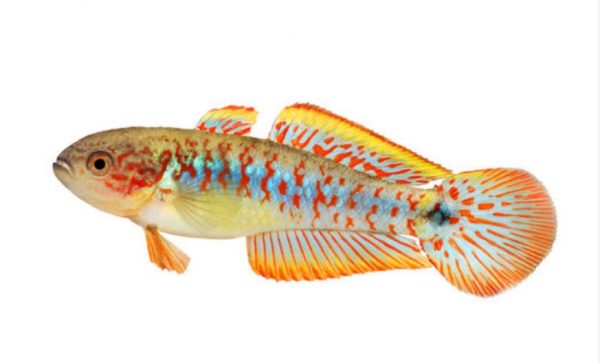
Like all aquarium fish, Peacock Gudgeon is susceptible to a variety of diseases. Keeping your aquarium clean with regular water changes and monitoring the water quality, as well as following the above feeding advice will do much to protect your Peacock Gudgeons from falling ill.
Ich, named for the parasite that causes it, Ichthyophthirius multifiliis, attacks when freshwater fish experience stress. Providing a stress-free environment for your Peacock Gudgeon is paramount in preventive care.
Stress can be caused by a number of things: improper tank mates or loneliness; overfeeding or lack of nutrients; incompatible tank or water conditions can all rob your fish of contentment, which makes them more susceptible to disease.
Fish infected with ich need to be quarantined because ich is incredibly contagious. There are many medicines on the market to treat ich. Just be careful as many of the medicines available are copper-based, and some of your Peacock Gudgeon’s tankmates may not do well with copper-based medications.
Besides ich, the Peacock Gudgeon’s head is somewhat susceptible to Hole-in-head disease, which they can contact through feces. Obviously, if you keep your tank clean, you will drastically reduce the chance that your Peacock Gudgeon will contact this disease that more commonly attacks larger fish.
Hole-in-head disease is visually unmistakable by the sores and pits in the poor fish’s head.
Also common are worms and parasitic infections: anchor worms latch onto the Peacock Gudgeon’s body and head, and they will rub against any hard items in your aquarium in an attempt to scratch themselves.
Fluke attacks are another condition that you should be on the lookout for. Small lesions are created when tiny little worms attach themselves to the skin and gills of the Peacock Gudgeon. If you catch the flukes early, you can usually treat the fish successfully with antibacterial and antifungal medications.
If the flukes are not identified early and the case is more severe, it could prove deadly for your Peacock Gudgeon.
Breeding
Peacock Gudgeon bond and form close relationships easily, unlike some other species that join only for reproduction and otherwise fight.
If you notice that two of your Peacock Gudgeons have formed a romantic match, you should move them to a special breeding tank, one that you have equipped with a cave or pot, or some type of cavity.
Set the stage for breeding by providing lots of quality live food and changing the water. The male will entice the female with a little dance, flaring his pectoral fins and swimming around the entrance to the love cave.
If the female is interested in sealing the deal, she will swim into the cave, laying 50 to 100 eggs. Because the eggs are adhesive, they may be on the side or even the ceiling. And then she’s out.
The rest of the breeding process is left to the male.
The male fertilizes the eggs and stays with them, watching over them as they incubate and watching over them like the protective father he is.
After the eggs hatch (about a week and a half), the male Peacock Gudgeon will leave the fry to take care of themselves. When this happens, the male and female can be returned to the community tank.
Until they grow enough to be able to handle baby brine shrimp, you should feed the Peacock Gudgeon fry powdered food and infusoria. They won’t swim on their own for a few weeks, so they’ll need you to keep them fed so that they can grow sufficiently.
Sometimes you might find that your Peacock Gudgeon prepares their own spawning set up in the community tank, especially if you provide a clean and well-appointed environment. They will arrange a proper egg-laying cavity and get down to business. In this case, you should keep an extra watch for the fry to make sure they’re safe from any other tank inhabitants until they are strong enough to survive on their own.
Are Peacock Gudgeon Suitable for your Aquarium?
Whether you’re a seasoned hobbyist or a novice, the Peacock Gudgeon really provides everything that you might need in a community member — they’re lovely to look at, are pretty adaptable and easy to care for, and have fun personalities.
A more advanced aquarist might just be up to the challenge of breeding these vibrant little fish, too. The fact that they get along with other tankmates and can be included in a larger community is an added bonus that might encourage you to choose 2 or 6 of these stunning fish.
Are Peacock Gudgeon your favorite community tank fish? Let us know why in the comments below…
FAQ
Why won’t my Peacock Gudgeon eat flake food?
Their preference for live food likely comes from the diet they are accustomed to in their natural habitat in Oceania. Aside from the fact that they enjoy going after live prey, they are omnivores that rely on the protein and fat that they get from live food.
If you provide them with a high-quality diet that offers variety, they will likely tolerate the flakes; just make sure it’s not their only nutrition source.
Do I need to have a separate breeding tank?
We have included instructions for breeding the Peacock Gudgeons in a dedicated tank, but the truth is your fish might not wait for you to set the breeding stage for them. Unlike some other fish species, these colorful fish do enjoy each other’s company and are likely to reproduce with little help from you.
If you have a cavity or cave in your community tank, you might just find some new fry and deduce that a pair of Peacock Gudgeons has laid and fertilized eggs without your knowledge. In this case, enjoy the fry, but keep a watchful eye for hungry tankmates and feed them powdered food and infusoria until they are grown enough to swim freely.
I’m just starting my fish keeping hobby. Would these fish be a good choice?
Congratulations on joining the exciting world of aquatic pets! Peacock Gudgeons are a great choice if you’re just starting out. They’re fairly easy to care for as long as you do regular water changes and check the tank conditions.
Another reason these are a good choice for a novice hobbyist is that they are just so fun to watch. They’re not only vibrant and beautiful to look at, but they have great personalities. They interact with each other and with other species in your tank. They’re playful, and when you see them swimming through the plants in the tank, it’s clear that they’re so happy.
We are sure that you are going to enjoy having the Peacock Gudgeons; it will probably spark your interest in fishkeeping even more! Good luck with your new hobby!
What is the average lifespan for Peacock Gudgeons?
Peacock Gudgeons have an average lifespan of 4-5 years in captivity.
How long does the female Peacock Gudgeon carry her eggs?
Actually, the female Peacock Gudgeons don’t carry their eggs at all. They lay their eggs in a cave or cavity that has been selected by the male and identified by the special mating dance that he does.
The female eggs are sticky, or adhesive, and could land anywhere in the cave. After the female leaves the cave, the male will go in and fertilize the 50 to 100 eggs left by the female. After fertilizing the eggs, the male becomes incredibly territorial in an effort to protect his young.
Once they are hatched, however, the male stays with the fry for only a short time before letting them fend for themselves.

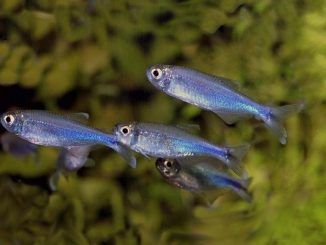
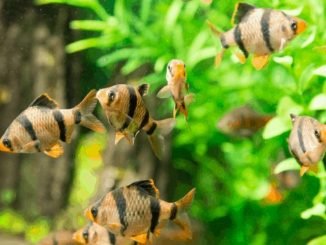
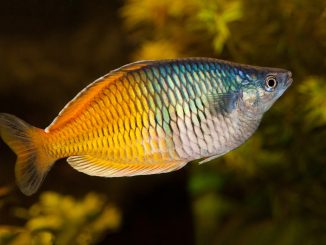
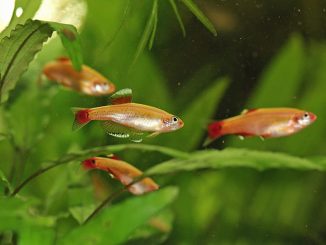
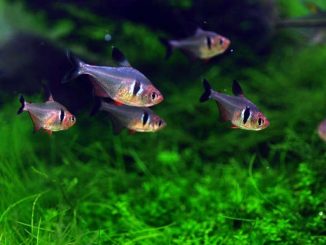
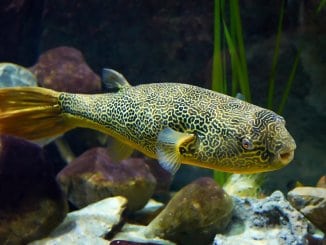
Hello, I’ve never heard of these until I came across this article. I’m thinking of peaceful fish to put in a 20 gallon long. Do these guys and Harlequin Rasbora occupy the same area of the tank, and if so would they feel cramped at all if I were to aim for maybe 6-8 each? I’m not sure if it’s advised to stick with one species per “level” within a community tank. Thank you.
I know this question is a year old, but I also have peacock gudgeons (3) and harlequin rasbora (10) in the same tank (180 litres). The gudgeons mostly mooch around the bottom, whereas the rasboras whizz along the top.